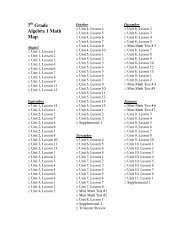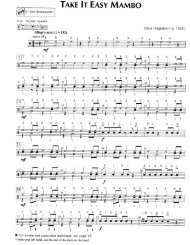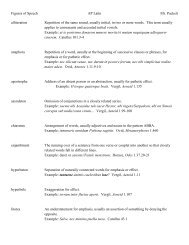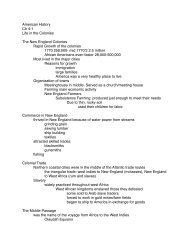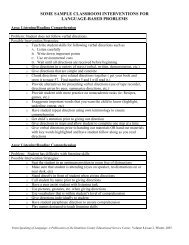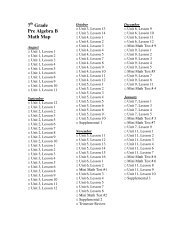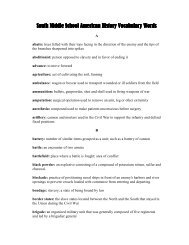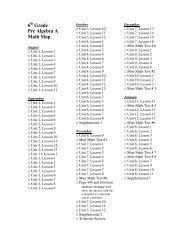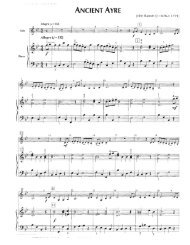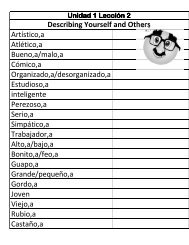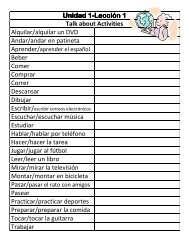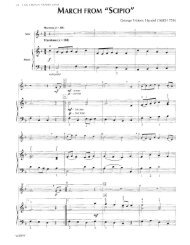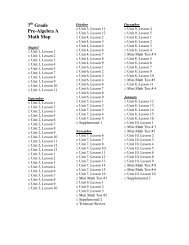The Circulatory and Respiratory System - Glencoe
The Circulatory and Respiratory System - Glencoe
The Circulatory and Respiratory System - Glencoe
You also want an ePaper? Increase the reach of your titles
YUMPU automatically turns print PDFs into web optimized ePapers that Google loves.
<strong>The</strong> Heart—Activity 3Name ________________________________________________ Date _________________ Class Period ___________Blood Flow SequenceCopyright © by <strong>The</strong> McGraw-Hill Companies, Inc. All rights reserved.Trace the blood flow through the heart, <strong>and</strong> learn the names ofimportant parts of the sequence. Try to follow the pathway of blood shownin Figure 1.4.<strong>The</strong> Pathway of Blood to <strong>and</strong> from the Heart1. Blood that has circulated through the body, which has lost its oxygen<strong>and</strong> collected carbon dioxide, enters through the vena cava into theright atrium of the heart.2. <strong>The</strong> right atrium contracts <strong>and</strong> pumps the blood through the tricuspidvalve <strong>and</strong> into the right ventricle.3. <strong>The</strong> right ventricle then pumps blood through the pulmonary arteryinto the lungs.4. In the lungs, tiny blood vessels called capillaries absorb carbon dioxidefrom the blood <strong>and</strong> replace it with oxygen.5. Oxygenated blood then flows through the pulmonary vein <strong>and</strong> intothe left atrium.6. Oxygenated blood then pumps through the mitral valve <strong>and</strong> into theleft ventricle.7. <strong>The</strong> left side of the heart contracts the strongest to send blood out theleft ventricle <strong>and</strong> through the aortic arch on its way to all parts of thebody. At this point, there are a few options for the blood flow: bloodcan be pumped• through the carotid artery <strong>and</strong> into the brain.• through the auxiliary arteries <strong>and</strong> into the arms.• through the aorta <strong>and</strong> into the torso <strong>and</strong> legs.8. Blood will then move through the arteries, then through capillaries,<strong>and</strong> then return through the veins.9. Deoxygenated blood (blood without oxygen) will then return to theheart.10. <strong>The</strong> cycle repeats.Fitness Zone Online <strong>The</strong> Heart
<strong>The</strong> Heart—Activity 3Name ________________________________________________ Date _________________ Class Period ___________Figure 1.4Entering HeartRight PumpLungsLeft PumpExiting HeartCollects bloodreturning frombodyGas ExchangeCarries oxygento all parts ofBodyVenaCavaRight AtriumPulmonary ArteryLeft AtriumTricuspid ValveLUNGSMitral ValveRight VentriclePulmonary VeinRight VentricleAorticArchHint: to help you remember arteries <strong>and</strong> veinsA (arteries) – Away Blood is moving away from the heart.V (veins) – Toward Blood is moving toward the heart.Capillaries are small blood vessels that connect C01-05A the arteries <strong>and</strong> veins.Blood Flow Sequence Activity<strong>The</strong> purpose of this activity is to underst<strong>and</strong> the sequence of blood flowthrough the heart, lungs, <strong>and</strong> body. Figure 1.5 illustrates different parts ofthe heart involved in the blood flow sequence.Students will develop their own challenge or obstacle course to indicatethe blood flow sequence. Partners or small groups may construct a partof the sequence. Make a drawing of the challenge course. For the actualactivity, use jump ropes, hurdles, cones, <strong>and</strong> other objects to indicate thedifferent parts of the system. Also, decide the sequence for using theseobjects. See if you can complete the challenge course three times whilesaying the name <strong>and</strong> function of each part of your sequence.Copyright © by <strong>The</strong> McGraw-Hill Companies, Inc. All rights reserved.Fitness Zone Online <strong>The</strong> Heart
<strong>The</strong> Heart—Activity 3Name ________________________________________________ Date _________________ Class Period ___________EvaluationLook at the parts of the heart in Figure 1.5, <strong>and</strong> describe the importanceof that part of the heart on the next page.Figure 1.5Branch to carotid arterySuperior vena cavaAortic archRight pulmonaryarteryLeft pulmonaryarteryLeft pulmonaryveinsLeft atriumLeft pulmonaryveinsPulmonary valveRight atriumTricuspid valveMitral valveAortic valveCopyright © by <strong>The</strong> McGraw-Hill Companies, Inc. All rights reserved.Right ventricleVena cavaC01-06ALeft ventricleSeptumFitness Zone Online <strong>The</strong> Heart
<strong>The</strong> Heart—Activity 3Name ________________________________________________ Date _________________ Class Period ___________1. vena cava ____________________________________________________2. right atrium __________________________________________________3. tricuspid valve ________________________________________________4. right ventricle _________________________________________________5. pulmonary artery ______________________________________________6. lungs ________________________________________________________7. pulmonary vein _______________________________________________8. left atrium ____________________________________________________9. mitral valve __________________________________________________10. left ventricle __________________________________________________11. aortic arch ___________________________________________________12. arteries ______________________________________________________13. capillaries ____________________________________________________14. veins _ _______________________________________________________15. Why must the heart contract very strongly to pump blood from theleft ventricle into the aorta?______________________________________________________________________________________________________________________________________________________________________Copyright © by <strong>The</strong> McGraw-Hill Companies, Inc. All rights reserved.Fitness Zone Online <strong>The</strong> Heart



